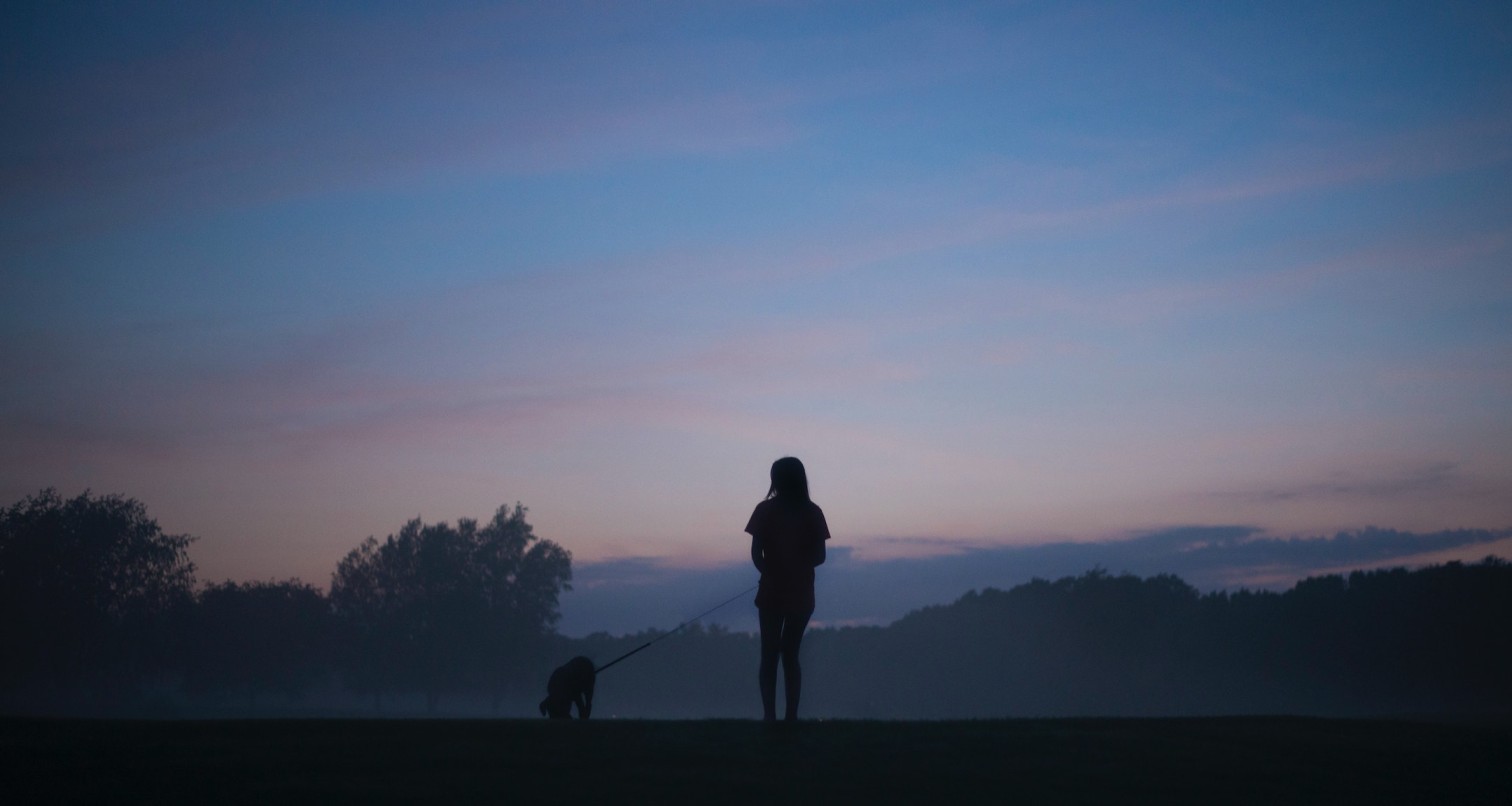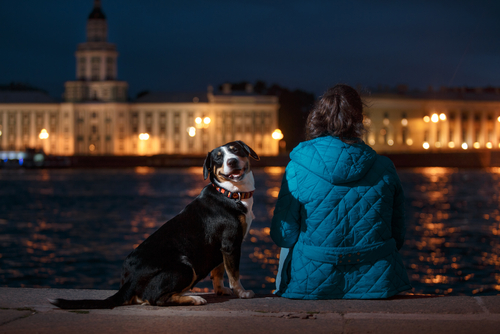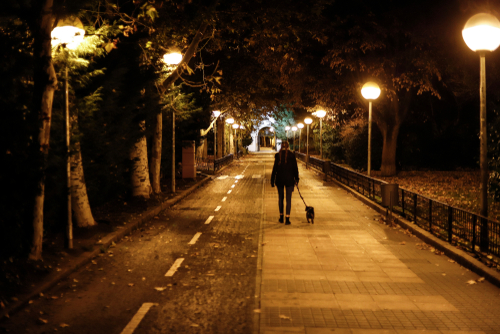5 Safety Tips for Walking Your Dog in the Dark
Posted: 01/08/2023 | BY: Erin Cain | Categories: Uncategorized
January is national “Walk Your Dog Month”! It’s that time of year when the leaves begin to change and fall from the trees, and your dog is happily exploring the scents of the fall season on your daily walks. Unfortunately, it’s also a time when we begin to lose daylight, and the morning outings and evening strolls in the sun are replaced by dusk and darkness. It’s important to walk your dog daily, especially for bonding purposes, but a darker environment means the potential for risky situations and dangerous accidents to occur. Here are five top safety tips for walking your dog in the dark.

1. Stay visible at all times
Drivers have a hard time adjusting to the change during daylight savings time, too. The result is an increase in driver-pedestrian accidents between October and December. Make sure you and your dog are wearing reflective vests that ensure drivers can see you in plenty of time to react. Dress in bright colors like white or yellow as those colors are highly visible at night.
LED leashes, collars, and harnesses are other excellent tools to use so your dog is highly visible to anyone in the neighborhood or on the road. Although reflective vests are helpful, LED lights are brighter and constant, so consider using a combination of this gear on your dog.

2. Stick to familiar territory
Walking your dog in the dark is not the best time to explore a new path, park, or neighborhood. Stick to the areas you and your dog know well, and always be alert to your surroundings. Walk against traffic, don’t wear headphones, and stay on the sidewalk if possible.
Pup parents should consider wearing a headlamp to help illuminate the sidewalks, grass, driveways, and roads they are walking on and prevent tripping, falling, and other injuries. A steady source of light is helpful, especially if your walks include any brushes with wildlife, like skunks, foxes, or raccoons. Plus, who wants to pick up pup poop in the dark? Your headlamp will make clean-up easy.
If a headlamp is too bulky for you, at least carry a working flashlight or battery-powered lantern with you on your walks.

3. Always have your pup on a leash
Always have your dog on a leash when you are walking at night or in the early morning hours. Even if you live in a quiet, low-traffic, or rural area, a leash is a must for your pup in the dark. It’s all too easy for a dog to become startled and run off or chase after an animal, becoming lost in the darkness. Even the best-trained and behaved dog can run off after a rabbit or a neighbor’s dog. Your pup has better night vision than you, which means she can see things in the dark before you even realize something is there.
Additionally, an off-leash dog is more likely to be struck by a car if she wanders into the road. If your dog is on a leash, you can prevent her from wandering into traffic where drivers will have difficulty seeing her in time to avoid an accident.
There are plenty of reflective and light-up leashes to choose from to walk your dog at night. Avoid using retractable leashes, though, as the leash line is difficult to see in the dark, meaning you and your pup may get tangled in it.
For pup parents of smaller dogs, a leash can keep your pup safe from being carried off by any birds of prey in the area. Although uncommon, a prey bird attack is always a possibility. It doesn’t take much time for a prey bird to swoop in and snatch a small dog; a leashed dog will have an added layer of protection in that situation.
4. Carry your phone with you
Have your phone with you when you walk your dog at night. For safety purposes, you can use your phone to dial emergency numbers, but your phone can make dog walking in the darkness a bit easier. Use the built-in flashlight on your phone as another light source, and download navigational walking apps to help you recognize your surroundings.

5. Avoid distractions
It’s tempting to check your phone, text, or listen to podcasts while you walk your dog. However, at night, those options may not be the safest actions to take. Make sure you are present and in the moment with your dog. Pay attention to her body language and what she is telling you. If you aren’t listening to your dog or carefully observing what’s going on around you both, you may not see a dangerous encounter coming. Check-in while walking your dog in the dark instead of checking-out.
Stay safe in the dark
A change in seasons doesn’t mean you have to stop walking your dog; it just means you need to approach those walks with more caution and care. With the proper attention and gear, you and your pup can continue to enjoy those walks safely all through the fall and winter.
Does your dog need a pet health insurance plan? Of course he does! A pet insurance plan will save you money while protecting your pet during unexpected accidents and injuries. Get your free insurance quote today!
References:
- AAA Mid Atlantic. (2019). End of Daylight Savings Time Spells Increased Driving Dangers. Retrieved from https://www.arlnow.com/press-releases/aaa-end-of-daylight-saving-time-spells-increased-driving-dangers/
- Lee, N., Orwig, J., Ludacer, R. (2017). How your dog sees the world differently. Retrieved from https://www.businessinsider.com/how-dogs-see-world-rods-cones-2017-9
- Mayntz, M. (2019). Protect Your Pets From Birds of Prey. Retrieved from https://www.thesprucepets.com/protect-pets-from-birds-of-prey-386699
- Wardle, N. (2016). 4 Apps to Make Your Dog-Walking Experience Even Better. Retrieved from https://www.intermountainpet.com/blog/4-apps-to-make-your-dog-walking-experience-even-better
Disclaimer
The information contained on this blog is intended for informational and educational purposes only and should not be construed as medical advice. It is not a substitute for professional veterinary care. Always consult with your veterinarian before making any changes to your pet's health care or treatment plan.
The authors of this blog are not veterinarians and do not claim to be experts in pet health. The information provided here is based on our own experiences and research, as well as information from reputable sources. However, we cannot guarantee the accuracy or completeness of this information.
We encourage you to do your own research and consult with your veterinarian before making any decisions about your pet's health.
Previous post
Hypoallergenic Dog Breeds | List of Hypoallergenic DogsCompare top pet insurance providers plans.
Enter your dog’s age in years and months to calculate their age equivalent to human years.
Calculate your dog’s ageEnter your cat’s age in years and months to calculate their age equivalent to human years.
Calculate your cat’s age